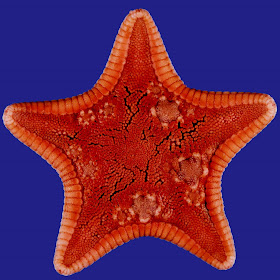At first, I thought that the name translated to "starfish (momiji) with babies" (but see below!)
WAIT! WHAT ?
I thought the word hitode (which incidentally translates to "palm") was the word for starfish??
 I also wondered how these seemingly formal Japanese names were formulated??
I also wondered how these seemingly formal Japanese names were formulated??Well, My good colleague, Dr. Yoichi Kogure at the Japan Sea National Fisheries Research Institue in Niigata Japan (shown here) saw my plea and proceeded to clarify!!
1. How are these Japanese names decided??
There are no strict rules for these names but apparently, there is a long tradition for the use of certain names. According to Dr. Kogure:
...most of the Japanese common names have been proposed in encyclopedias or picture books. In fact, we can see some wood prints of starfishes with common names in the encyclopedia published in the Edo period. The attached picture is the sea star and sand dollar in the encyclopedia published by Ryoan Terajima, a Japanese medical doctor in the Edo period, in 1712.
 Wow!!! LOOK at that!! Astropectinids recognized from 1712!!!! I'll have to check but this might one of the OLDEST recognized names of starfish!!
Wow!!! LOOK at that!! Astropectinids recognized from 1712!!!! I'll have to check but this might one of the OLDEST recognized names of starfish!!2. What is the difference between momiji and hitode???
So, we now have TWO Japanese words for "starfish". Hitode and momiji.
For example this species (Ctenophoraster diploctenius) has the Japanese name: udenaga-kagitoge hitode
This translates to: udenaga=long arm kagitoge=hooked spine and hitode=starfish
(see the Japanese name from a recent paper here.)It turns out that momiji translates to "maple leaves tinged with bright red" and is the Japanese word for "astropectinid (or at least astropectinid-like) starfish"!!! The name apparently refers to starfish with this particular body form.
 To quote Dr. Kogure:
To quote Dr. Kogure:The name momiji is short for momiji-hitode or momoji-gai. As you know, hitode is the most common use of the Japanese word to indicate sea stars. The word gai or kai means shellfish in Japanese. Our remote ancestors considered that the sea star was one of the groups of seashells. The Japanese common names of sea stars have hitode in most of the species, or momiji in some groups. For example, we can see the word momiji in some astropectinid sea stars and goniasterid sea stars such as Pseudarchaster parelii (aka-momiji: red sea star).3. Examples!
Below is Ctenopleura ludwigi, whose Japanese common name is oh-nise-momiji.
This Japanese species-Astropecten latespinosus has a pretty well flattened body. Japanese name is hira momiji.
Hira means "flat"..so "Flat astropectinid" (to contrast-the latin latespinosus refers to the lateral fringe of spines around the edge of the body)
Hira means "flat"..so "Flat astropectinid" (to contrast-the latin latespinosus refers to the lateral fringe of spines around the edge of the body)
 (all starfish photos by Yoichi Kogure)
(all starfish photos by Yoichi Kogure)
Astropecten kagoshimensis with Japanese name: kurosuji-momiji
kurosuji translates to "striped with black" which, well....seems kind of obvious:
 (all starfish photos by Yoichi Kogure)
(all starfish photos by Yoichi Kogure)
Dipsacaster pretiosus -another deep-water Japanese astropectinid starfish with Japanese name: hadaka-momiji
Hadaka means "naked" and likely refers to the featureless surface around the edge of the animal.
Hadaka means "naked" and likely refers to the featureless surface around the edge of the animal.
 (all starfish photos by Yoichi Kogure)
(all starfish photos by Yoichi Kogure)Leptychaster anomalus with Japanese name: usu-momiji. Usu means "thin" (and the animal is indeed quite thin)
 (all starfish photos by Yoichi Kogure)
(all starfish photos by Yoichi Kogure)..and the related Leptychaster arcticus?? Japanese name is kita-usu-momiji
Kita refers to "northern" (L. arcticus is a species that lives in an Arctic/subArctic band) and follows the Leptychaster format for "thin" = usu
 HUGE thanks to Dr. Yoichi Kogure for his help and information that contributed to this post!
HUGE thanks to Dr. Yoichi Kogure for his help and information that contributed to this post!


Awesome!
ReplyDelete